Carol Beth Anderson's Blog
October 30, 2021
Dog House (a Short Story)
It started with a sorcerer.
Don’t tune me out, please—I get it. I didn’t believe in them either. Until one cast a spell on me.
I’d lived selfishly, exceptionally so. Affairs, betrayed friendships, and a decades-long history of littering. It’s a boring story, really, and not the one I’m here to tell.
I was lying in bed in a public hospital after eighty-four years of narcissism that had left me quite alone, when a nurse with curly, black hair and green eyes showed up. “Hello, Mr. Lewis. I’m a sorcerer.”
“Not a sorceress?” I’m not sure why that’s the question that pushed itself through my dry lips, but there’s a lot about the man I was that I’ll never understand.
“We’ve gone to gender-neutral titles.” She proceeded to inform me that, due to my supreme selfishness, I would spend my next life as a dog.
She lifted her hands and spoke several words I’d never heard.
And then I died.
***
I don’t remember being born. I came to awareness while drinking warm, sweet milk from the teat of a tired dog.
All at once, I knew who I was, what I’d done, and the punishment I’d been sentenced to. I stopped eating and looked around.
That woman hadn’t just made me a dog, she’d made me one of a litter of nine mutts, all with stubby legs, boring brown fur, and ridiculously floppy ears. And she hadn’t sent me to live with a family. I was surrounded by chain link, barks, and stink. An animal shelter.
Damn sorcerer.
I shoved one of my siblings to the side and latched on to my mother, my puppy instincts warring with my very human fury.
Once I was no longer hungry, my mind cleared. The sorcerer might’ve set me up for failure, but I was in control of my own life now. I’d go for what I wanted. The way I always had.
The next day, when people came to look for pets, I sat up straight, wagged my whip-like tail and let my tongue hang out of the side of my mouth.
It worked.
A young woman and her husband fell in love with my soft belly and lolling tongue. I listened as they discussed me with the staff. Weeks later, Ed and Sheila brought me to live at their little house in the city. They named me Moby, after the whale. (My belly was quite round.)
***
I expected to live a life of ease in my new home. Quickly, I realized my error.
A dog has little control over his existence. Ed taught me to ring a little bell with my nose when I wanted to go outside. All his high-pitched praise couldn’t take away the humiliation of ringing a bell to ask permission to piss.
And the food—how to describe it? Dog food is like greasy, meat-based dry cereal. It tasted better than I expected, but eating it day after day was torture. I wanted to growl at Sheila, “Do you have any idea how many five-star meals I’ve eaten? And you give me this?”
Anxiety slithered into my little gut. Would they ever forget to feed me? What if I ventured into the bathroom, accidentally bumped the door closed, and got stuck? And the big birds I occasionally saw outside—would one snatch me from the yard and make me its breakfast?
As I became daily more aware of my lack of agency, I swear my sensitive canine ears heard the sorcerer’s high-pitched cackle.
I responded the same way I would’ve when I was human. I took what I wanted instead of waiting for someone to give it to me. If the front door opened, I darted out to mark as many neighbors’ mailboxes as I could. I jumped on the one chair that was off limits. Its upholstery was rough on my skin, but I still napped on it for hours when my owners were at work. I chewed on leather shoes (a surprisingly delicious habit).
Sheila and Ed became more and more frustrated. “Why, Moby?” they’d ask as they chased me through the neighborhood or held up another ruined shoe.
If I were capable of laughing, I would’ve. However, their sighs and chiding words affected me, despite myself. Sometimes I caught my ears drooping, and my tail tucked itself between my legs. I never would’ve admitted it, but I missed their smiles and cooing words.
Then, one day, I smelled it—my very favorite scent. Sheila was cooking chicken.
You don’t realize, you can’t understand, how meat smells to a dog. I don’t care how many incredible restaurants you’ve been to, with French-trained chefs and creamy sauces and buttery desserts. I don’t care what delectable odors wafted from your grandmother’s Thanksgiving table. Nothing you’ve smelled as a human can compare to the scent of sizzling chicken when you’re a dog. Drool collected in my mouth as soon as I caught a whiff.
I stood there, tongue darting out repeatedly, eyes wide, tail twitching, silently begging Sheila for a bite.
She was in a hurry, ingredients and pans scattered over the kitchen as she worked on the chicken and a variety of less interesting dishes. “When do your parents get here?” she called as she swept the back of her hand over her flushed forehead.
“Fifteen minutes!” Ed replied from where he was frantically dusting the living-room furniture.
Sheila cursed, then muttered under her breath, her fears emerging in short phrases—“They won’t like it.” “They don’t like me.” “I’ll mess this up.” Not once did she look at me, sitting there with hope written all over my little body.
She finished the chicken and set it on the dining table in the next room. When she went to the entryway to welcome her in-laws, a quick hop brought me onto a chair. Another jump, and I was on the table.
Then I was in heaven, tearing into the chicken, gulping down huge bites of it. It was savory and moist and altogether perfect. I got through a breast and two thighs before Sheila and Ed appeared, leading his parents into the room. I froze. My traitorous tail slipped between my legs.
Ed’s mother let out a soft gasp.
A sob burst from Sheila’s mouth, echoing off the walls, followed by the pounding of her feet as she ran into the kitchen.
My gaze met Ed’s. He’d never laid a violent hand on me, but I truly believed I could smell his fury. A single leap, and I hit the floor, my feet skidding in four directions on the slick wood. I recovered and followed Sheila into the kitchen.
I’m not sure why I didn’t run straight through the room and find a quiet corner to sit in. I saw Sheila sitting on the tile floor, muffling her cries with her hands, and found myself walking to her and sitting in front of her. The tile was cold on my little rump, but I stayed there, waiting.
Sheila looked up. “Oh, Moby,” she choked out. “Why?”
Something squeezed at my heart, something I didn’t remember ever feeling.
Regret.
The chicken got heavy in my belly. More than ever, I wished I could talk. Since I couldn’t, I leaped onto Sheila’s lap. I nuzzled her neck, and my tongue found her cheeks and kissed away her salty tears.
She held me close to her soft chest for a long time, then pulled back and met my gaze. “I forgive you,” she whispered.
No one had ever told me that before. I guess it was a day for firsts.
***
Things changed after that. I changed. I didn’t run out the door or sit on the forbidden chair. I didn’t steal leather shoes or food. (Not often, anyway.)
Ed and Sheila frequently scratched behind my ears and called me a good boy, and I could tell they meant it.
At last, I truly settled into my role as a pet. In many ways it remained uncomfortable, being totally dependent on others and having such limited communication skills. But there was a certain beauty to the simplicity: playing and eating, walking and napping.
I stopped growing and was pleased to find my head had reached the level of my owners’ knees. Not too long after that, Sheila began to grow. She and Ed had one baby, then another two years later. I got less attention from the adults and sometimes too much from the toddlers in the house.
Months passed, then years, full of the crunch of boring dog food and the petting of hands big and little and the divine smell of cooking chicken (and, when I was lucky, the taste of it).
One day, when the kids were at school and Sheila and Ed were at work, I lay in a band of warm sunlight on the wooden floor of the living room, watching dust motes and listening to the gentle whoosh of the fish-tank pump. I’d learned to appreciate those times of relative quiet, even though my ears perked up at every small noise as I waited for someone to return home. In that lazy space between sleep and alertness, I considered my unique role in this house.
When Ed, Sheila, and the kids left for work and school, I remained. In those times, I was the only one to hear the thunk of packages on the front porch. When the family went out to dinner, I alone admired the purple-and-salmon sunset through our back window.
Being canine, I detected scents that the humans in the house were unaware of. A home, especially one with children, is a wonderful place for a dog’s nose. The house was full of the odors of dropped food and dirty laundry, along with the intriguing, slightly jealousy-inducing scents brought back by anyone who’d been socializing with other dogs.
And in becoming a dog, I’d lost my human inhibitions. If something smelled amazing, I’d taste it, at least once. I was the only one in the home to know the flavors of dirty socks and crumpled tissues and that one sticky spot on the kitchen tile that sat for weeks before getting mopped up. (Don’t knock any of it until you try it.)
Most importantly, the members of the household felt safe around me. I heard the parents’ quiet conversations about their kids, and I heard the scheming of the kids planning to pull something over on their parents. When someone was angry and didn’t want to be touched by human family members, their hands found me, burying in my fur, scratching that wonderful spot on my neck. I was party to more interactions in this place than anyone—I was the quiet observer, the secret keeper, the comforter.
A home, I thought as I lay in the sunlight, belongs more to a pet than to their humans. The honor of that, the wonder of it, made my eyes heavy with something that would’ve been tears if I could produce them.
This was my home. It was full of the scent of cooking chicken and the taste of dropped crumbs. It featured beaming faces and the click of my toenails. It was lush with the promise of warm hands reaching out for soft fur.
My home.
***
The kids are in elementary and middle school now. Ed’s going bald, and Sheila’s embracing her first strands of gray hair. I suspect this canine life is coming to an end before long.
Sheila told Ed this morning that my vet retired, and the new one will do house calls for an extra fee. She kneels next to me. “Wanna get your checkup here or at the office?”
I used to love occasional rides in the car. But now, the area rug on the floor feels cozier than ever. I roll on my back, and Sheila laughs and pets my belly. “I’ll ask her to come here.”
When the doorbell rings, I don’t run to it like I used to. My ears perk up and my tail thumps as I wait. There are murmurs in the entryway, and as they come closer, I make out a few of the visitor’s words: “Sounds like he’s earned these restful days.” The voice is vaguely familiar.
“He’s a good boy,” Sheila says.
They enter the living room, where I’m lounging. All at once, my entire body stiffens.
The smiling vet has curly, black hair and green eyes.
The sorcerer.
She kneels and says, “It’s okay, Moby. I’m not here to hurt you.”
For some reason, I believe her. I relax and let her examine me.
When she’s done, she speaks to Sheila, but she’s still looking at me. “I think you’ve still got some time with him.” Her voice is gentle. “And I think this life with you is just what he needed.”
I give her a little nod. Her lips twitch with a half-smile, and for the first time, I consider what it will mean to leave my home. To find rest at last.
I think I’m almost ready.
THE END
 Photo by Scott Webb on Pexels.com
Photo by Scott Webb on Pexels.com
October 22, 2021
Audiobook Production Spreadsheet: A Tool For Narrators / Producers
I like to track my production time when I narrate and edit an audiobook. I also like to keep an eye on the pacing of my narration. (Am I speaking too fast or slow?)
This spreadsheet helps me track all of that. I hope it helps you too!
[image error]Download a blank version right here for free. (You’ll be taken to Dropbox for your download.)
I suggest you make a copy of the spreadsheet for each book, and keep the blank one in your files too. Every time you start a new book, make another copy.
Here’s a quick video tutorial on how to use it:
Note 10-28-22: I’ve revised this spreadsheet, adding extra features. The link will send you to the new version. The video is NOT updated, but the new version has an Instructions tab that will give you info on how to use it.
Comment with any questions!
Want to be notified every time I post an Author Resource?
.grecaptcha-badge { visibility: hidden; }First Name:
Last Name:
Email:
I agree to receive email updates and promotions.
Submit
Author Resources on my website are 100% free. But if you’d like to buy me a coffee to thank me, click the “Tip Me” button below!
Tip MeAudiobook Production Spreadsheet: A Tool For Narrators/Producers
I like to track my production time when I narrate and edit an audiobook. I also like to keep an eye on the pacing of my narration. (Am I speaking too fast or slow?)
This spreadsheet helps me track all of that. I hope it helps you too!
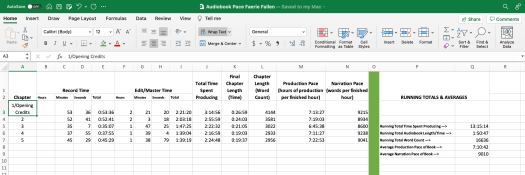
Download a blank version right here for free. (You’ll be taken to Dropbox for your download.)
I suggest you make a copy of the spreadsheet for each book, and keep the blank one in your files too. Every time you start a new book, make another copy.
Here’s a quick video tutorial on how to use it:
Comment with any questions!
Author Resources on my website are 100% free. But if you’d like to buy me a coffee to thank me, click the “Tip Me” button at the bottom of the page!
July 17, 2021
Hardcovers are Here (and I Have Coupon Codes!)
BIG NEWS! Hardcovers for The Magic Eaters Trilogy (plus the prequel, The Seer’s Sister) are available for the first time ever … and I have coupon codes for signed copies!
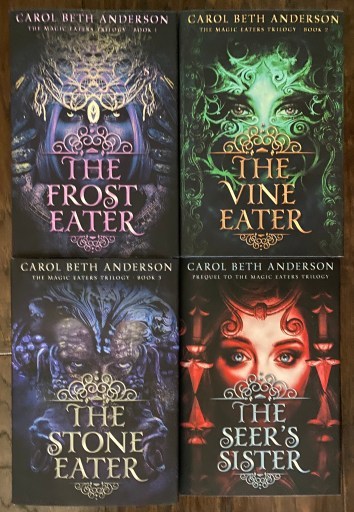
Aren’t they gorgeous? Thank you to my amazing cover designer, Mariah Sinclair, who did a gorgeous job with these!
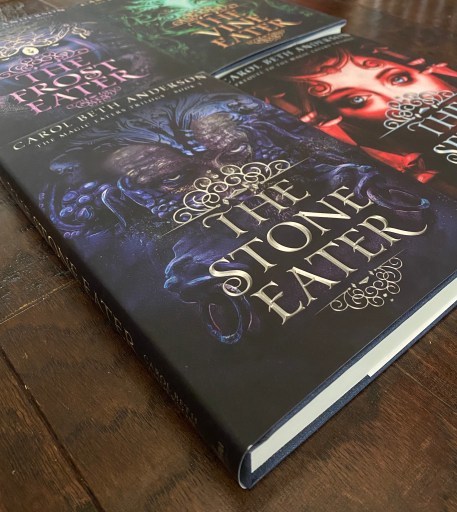
Because I cut out the middle man when I sell these on my website, I can give you a discount. They’re already on sale, and I have coupon codes to make them even more affordable!
COUPON CODES (HARDCOVER):
FROSTHARDCOVER: $3 off The Frost Eater hardcover (total of $5 off with the existing sales price)SERIESHARDCOVER: $8 off the entire series in hardcover (total of $18 off with the existing sales price!)I also have paperbacks of The Seer’s Sister for those looking to complete their Magic Eaters series in paperback. And I got in a new shipment of paperbacks of the rest of the series too!
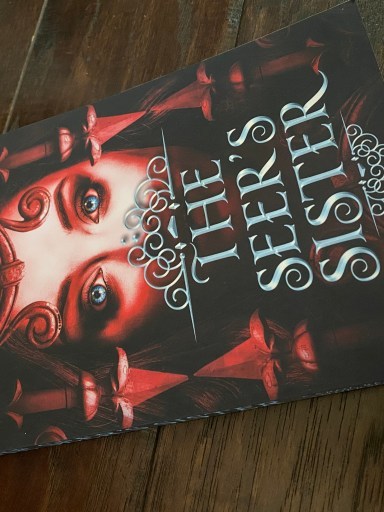
Once again, I have coupon codes for those kind enough to purchase my signed copies from this website.
COUPON CODES (PAPERBACK):
SEERPAPERBACK: $2 off The Seer’s Sister in paperbackSERIESPAPERBACK: $4 off all 4 books in paperback (total of $10 off with the existing sales price)Click here to order your signed copies! (And yes, hard copies are available through Amazon and other websites throughout the world if you prefer to order that way.)
Enjoy these stories of magic, dragons, adventure, and love!
July 6, 2021
Release Day for The Seer’s Sister!
The Seer’s Sister, the full-length prequel to The Magic Eaters Trilogy, is here!
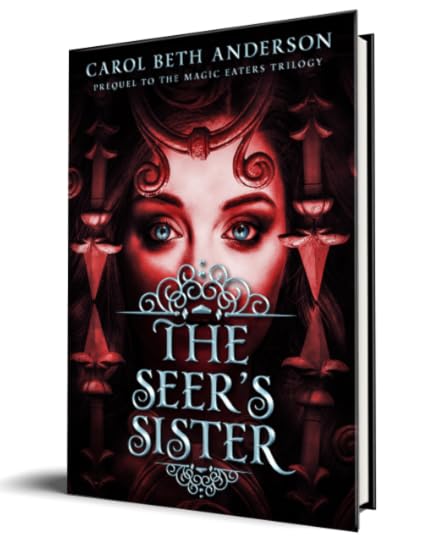 E-Book: AmazonPaperback: Amazon, Barnes & NobleSigned Books: CarolBethAnderson.comAudiobook: Amazon, iTunes, and Audible.com
E-Book: AmazonPaperback: Amazon, Barnes & NobleSigned Books: CarolBethAnderson.comAudiobook: Amazon, iTunes, and Audible.com
May 12, 2021
Author Resource: Atticus is a Formatting Software Alternative to Vellum (for Windows, Mac, Linux, and Chromebook)
I’m a huge fan of Vellum, software that formats ebooks and print books. It’s fantastic, user-friendly software and one of the investments I’ve been happiest that I made in my writing business.
However, Vellum is only available to Mac users. PC users often subscribe to the MacInCloud service to use Vellum, but for various reasons, many authors consider MacInCloud to be less than optimal.
Enter Atticus, a new formatting software that Dave Chesson from Kindlepreneur is putting out. It’s for Windows, Mac, Linux, and Chromebook. Here’s a screenshot:
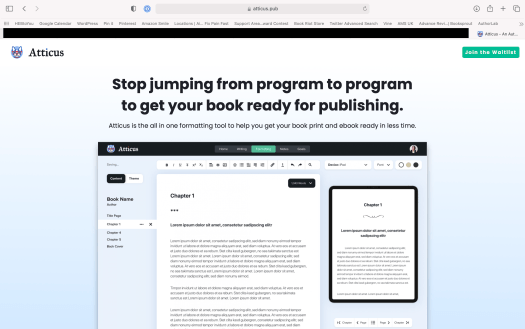
I’m not planning to purchase Atticus, since I have a Mac and have already invested in Vellum. However, several days ago, I signed up to join their waitlist. I got an email today letting me know the first version of Atticus is available for a “special (secret) price” to early adopters. I don’t want to disclose the price here since it’s not public, but it costs far less than Vellum. It’s a one-time purchase that includes updates.
To sign up and get the chance to purchase Atticus, you can visit Atticus.pub.
Here are some observations I made as I looked into Atticus:
It’s pretty basic right now, but they have other features coming that will enable it to compete better with Vellum. These features will be free for all users. Check out their Roadmap to Launch for more info on the features.It looks like Atticus will only generate ePub and print-ready PDF files. Those are perfect for uploading to Amazon and other platforms/distributors. However, If you want to share your manuscript directly with Kindle users (for instance, your alpha, beta, or ARC readers), you’ll need to convert the ePub to a mobi so they can “sideload” the file onto their Kindle. You can do this on BookFunnel (instructions here—they’re written for Vellum users, but this should work for Atticus users too) or using various free services like convert.io.If you decide to try Atticus, I’d love to hear what you think. And may I just say … hooray for a Vellum alternative for non-Mac users!
April 1, 2021
My Trilogy is Complete…and I’m Giving Away Books
I am over the moon. The Magic Eaters Trilogy is complete! It’s Launch Day for The Stone Eater.
To celebrate, I just finished drinking a massive Frappuccino. I’m also celebrating with you by putting the ebooks on sale for The Frost Eater (FREE, the best kind of sale) and The Vine Eater ($1.99). They’re only on sale for five days, through April 5. Check them out on Amazon.
Prefer paperbacks? When they’re this gorgeous (thank you, designer Mariah Sinclair!), I don’t blame you! For readers in the US, the entire series is on sale. Get all three books, signed, for $39.97 ($10 off the price if you purchased individually)! Snag the series here.
Raise a glass for me—it’s a day of celebration!
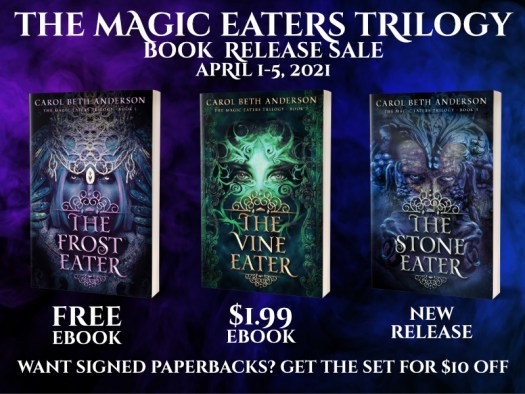 https://www.amazon.com/gp/product/B0847F3XRV
https://www.amazon.com/gp/product/B0847F3XRV
March 3, 2021
Author Resources: Whose Head Are You In? Writing Multiple Points of View
On an ordinary day not too long ago, three characters gathered in a library.
Alpha drew in a deep breath. The scent of leather and paper filled her lungs. Intoxicating. Could there be a more perfect location than an old library?
“Excuse me,” someone said.
Alpha turned. “Hey, Beta! Isn’t this place great?”
Beta glared at her. He’d just been musing about whether he should climb a ladder to the higher shelves, but her thoughts had distracted him. “You’re obsessing over the scent of paper?” he said. “Really?”
“First, stay out of my head. Second, if you don’t understand the allure of old paper, you’re beyond help.”
“Could you both please shut up?” Gamma looked over her reading glasses at the other two. They were always like this, bickering constantly, when all she wanted—
“ ‘Bickering constantly?’ ” Alpha and Beta said in unison.
“How’d you hear my thoughts?” Gamma asked. “This scene is supposed to be in my point of view.”
“Apparently we’re all sharing the scene,” Alpha said. Sensing the silent groans of the two others, she looked at the ceiling, hoping the mythical Author of All Things was listening. “Hey, you! Word Lord! This is confusing!”
 Photo by
Olya Kobruseva
from
Pexels
Photo by
Olya Kobruseva
from
Pexels
Authors, any chance your characters—or readers—are as confused as these three, as you hop from one point of view to another?
Many of us, at one point or another, choose to write a novel with more than one point of view (or POV). I’ve written two trilogies in third person with multiple POV characters, and I’ve enjoyed the process thoroughly. It’s a blast exploring the thoughts of the hero and the villain or of both halves of a romantic partnership.
Multiple POVs can deepen and enrich narration, but they can also cause frustration for authors and readers. In this post, we’ll discuss how to use multiple POVs effectively. And while some talented authors write first person with multiple narrators, today we’ll focus on writing in third person.
There are two ways to write in third person with multiple POV characters: third person omniscient and third person limited.
When using third person omniscient, your narrator isn’t a character in the story, but they’re privy to the thoughts of every character in the story. Your narrator can give the reader a glimpse of the thoughts of multiple characters in one scene. Here’s an example:
Dan drove slowly, hoping the vase of flowers on the passenger’s seat didn’t topple over. He parked in his driveway and walked toward the front door.
Alma saw him coming from the kitchen window. Her pulse quickened when she saw the flowers. Unexpected gifts were her favorite sort. But she had to wonder if he was trying to make up for some transgression.
As the reader, we “hear” Dan’s thoughts (hoping the vase doesn’t fall) as well as Alma’s (who loves unexpected gifts but doesn’t quite trust her partner).
The second way to use multiple POVs in third-person writing is to use third person limited with multiple POVs. As with omniscient, the narrator isn’t a character. However, with this technique, the reader is only privy to one character’s thought per scene. Here’s the above scene, written in third person limited:
Dan drove slowly, hoping the vase of flowers on the passenger’s seat didn’t topple over. He parked in his driveway and walked toward the front door.
He saw the outline of Alma’s figure in the window. She’d told him a hundred times how much she loved unexpected gifts. He hoped she’d still love these roses when she heard the confession they came with.
In this case, we don’t have any idea what Alma is thinking. However, the next scene could be in her POV, which would allow us to get inside her head after her partner fesses up.
If you choose to write in third person with multiple POVs, you get to decide whether to write in omniscient or limited. I believe that in most cases with most modern books, limited is a better choice than omniscient.Here are several reasons why:
Embrace a Modern Style
Omniscient POV is a more classic style, so if you’re writing modern literature for modern audiences, it can easily feel dated. Limited (with multiple POV characters) is a more modern style. Many of today’s readers like to read one POV per scene, and if you plan to query agents and/or publishers, they may also prefer limited over omniscient.Avoid Head Hopping
Omniscient POV can easily turn into head hopping.What’s head hopping? It’s a when the narrator hops from one character’s head to the next within the same scene. Readers use the term head hopping when POV shifts feel jarring and/or happen too frequently. It’s possible to write in omniscient POV without head hopping. However, it can be difficult, and even if you think you’ve avoided head hopping, reviewers may disagree.Immerse Your Readers in Your World
With limited POV, readers may more easily feel connected to your story and characters since they’re “spending time with” one character for an entire scene or chapter (or longer).Limited POV is like going to a party and sitting with one person all night, really getting to know them, rather than hopping from one table to the next, having quick conversations.You can give your readers the gift of depth and immersion by spending time in the head of one character per scene.Go Deep
Limited POV allows you to easily shift into “deep” (also called “close”) POV, a subset of third-person POV.In deep POV, you get so deep into your character’s head that the lines between narrator and POV character get blurred. Example: With a distant (not deep) POV, you might write, “Jarvis took the pickles off his burger. He couldn’t believe they’d gotten his order wrong again.” With deep POV, you could instead write, “Jarvis took the pickles off his burger. They’d gotten his order wrong…again. Unbelievable.” Note how the narration took on the tone of Jarvis’ thoughts. If you use deep POV within omniscient narration, there’s a good chance you’ll be accused of head hopping. Omniscient narrators need to stay distant so they can shift from one POV to the next without giving readers whiplash. Limited narrators can go deep.If you decide to write in third-person limited POV with multiple POV characters, here are some tips to help you succeed:
Keep it Manageable
There are no hard-and-fast rules about how many POV characters you can use in third-person limited, but a smaller POV cast is often more effective than a bigger one. If you get inside too many characters’ heads, your readers may not connect with any of them. Sure, it would be fun to know exactly what the quirky candy-shop owner is thinking, but if she doesn’t play a major role in your book, she should stay in the background.Some genres tend to have more POVs than others. For instance, if you write epic fantasy, your readers may accept several well-written POVs. If you write romance, your readers may expect only two.One POV Per Scene or Chapter
Only shift POVs at scene changes or when you start a new chapter.If shifting at a scene change, indicate the change with an ornamental break between the scenes. A common ornamental break is three asterisks (***). It should be on a line by itself, centered.Identify Your POV Character Quickly
Some authors include the POV character’s name at the beginning of the scene or chapter, as a heading, like this:Chapter 1
Mei
Regardless of whether you use the character’s name as a heading, indicate whose “head” you’re in quickly, so your readers can “center themselves.” For example, instead of starting a chapter or scene with, “Gold, pink, and orange clouds covered the eastern sky,” you could write, “Mei faced the gold-and-orange clouds in the east, letting the sunrise burn away her fear.”Use Reaction Scenes
If you’re used to writing in omniscient POV, it can be hard to give up the freedom of hearing two characters’ thoughts within the same significant scene. You’ve spent an entire book building up to a big kiss, and now you’re supposed to only show it from one POV? Well, yes…but you can follow up with a scene showing the second character’s reaction to the big scene.Example: In the book you’re writing, your two main characters, Ahmed and Rose, get kidnapped. First, show the kidnapping from Ahmed’s POV, focusing on his terror. By staying in his head, you’ll keep your readers on the edges of their seats, totally immersed in the intense scene. Once your poor characters are locked in a tiny cell together, follow up with a scene from Rose’s POV, showing how she’s hiding her own fear so she can comfort Ahmed.Let’s go back to the scene we started with. Imagine if we’d stayed in Alpha’s head the whole time. It might’ve gone something like this:
Alpha drew in a deep breath. The scent of leather and paper filled her lungs. Intoxicating. Could there be a more perfect location than an old library?
Her gaze fell on Beta. He was climbing a ladder that leaned against a bookshelf so tall, Alpha had to crane her neck to see the top. The rickety ladder squeaked as his foot moved to the next narrow rung. One of these days, Beta was gonna get himself killed. But if it happened in this place, Alpha supposed he’d die happy.
A gasp got her attention. She turned to see Gamma standing next to a stack of books almost as tall as she was—and Gamma was tall. Her eyes looked huge behind her reading glasses as she examined the pages of an old tome, her mouth gaping.
Beta and Gamma were both so immersed in their tasks, they seemed to have forgotten Alpha existed. It’s now or never.
Alpha walked silently toward the southwest corner of the library. Her heart pounded and her mouth went dry as she approached the shelf of forbidden books.
Better, right? As the reader, you got to delve deep into Alpha’s mind, experiencing her time in the library right along with her and seeing her friends from her perspective. Maybe the next chapter will be in Beta’s or Gamma’s POV, but for now, you’re immersed in Alpha’s story.
There are no right or wrong points of view. However, if you’re a modern author planning to use multiple POVs in third-person writing, I encourage you to stay focused on one POV per scene or chapter. Your readers will thank you for bringing them along on a captivating, non-confusing ride…and maybe your characters will too.
Want to be notified every time I post an Author Resource?
Author Resources on my website are 100% free. But if you’d like to buy me a coffee to thank me, click the “Tip Me” button at the bottom of the page!
kofiWidgetOverlay.draw('carolbethanderson', { 'type': 'floating-chat', 'floating-chat.donateButton.text': 'Tip Me', 'floating-chat.donateButton.background-color': '#794bc4', 'floating-chat.donateButton.text-color': '#fff' });February 25, 2021
Author Resources: How to Download Booksprout Reviewer Email Addresses
I love Booksprout, a website that allows authors to connect with ARC reviewers. One of the reasons I continue to us them is because they provide me with reviewer email addresses so I can contact reviewers with reminders and information. (I discuss this in more detail in Early Readers Catch the Worms: How Alpha, Beta, & ARC Readers Can Help You Publish a Better Novel).
But one thing has always bugged me about Booksprout: they don’t give me a way to download those email addresses. I’ve always individually copied and pasted each one into an email, which feels like a waste of time.
Today, I figured out how to easily download the email addresses using a free Chrome extension! This 3 1/2-minute video will show you how.
Want to be notified every time I post an Author Resource?
Author Resources on my website are 100% free. But if you’d like to buy me a coffee to thank me, click the button!

February 23, 2021
Author Resources: Early Readers Catch the Worms
It’s here! Early Readers Catch the Worms: How Alpha, Beta, & ARC Readers Can Help You Publish a Better Novel is now on sale in ebook and paperback formats.
Authors, get the book that publishing expert Derek Murphy of Creativindie calls a “detailed guide” that “simplifies the process” of working with early readers.
•••
Empower yourself to build teams of alpha, beta, and ARC readers who follow through and help you write better novels!
Ever throw away an apple because you found a worm inside? Worms slither into novel manuscripts too … weaknesses and errors that make readers want to throw away a book (or trash it in reviews)! But effective early readers catch those worms.
This comprehensive guide will teach you to get results from your alpha and beta readers with these tools:
-Practical, step-by-step methods for building and optimizing early reader teams-Simple strategies to improve reader follow-throughAccess to over a dozen editable templates for communicating with alpha and beta readers
Jumpstart your book launch with early reviews! This book is packed with tips for building an ARC (Advance Review Copy) team, including:
-Where to find ARC readers-How to encourage ARC readers to actually leave reviews-A fun way to incentivize ARC readers to find your lingering typosWhether you’re already published or about to write your first book, Early Readers Catch the Worms will help you crack the code on early reader systems so you can write a novel that readers want to buy.
Get the feedback you need … before you publish.
 E-Book: AmazonPaperback: Amazon, Barnes & Noble
E-Book: AmazonPaperback: Amazon, Barnes & Noble



